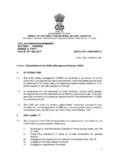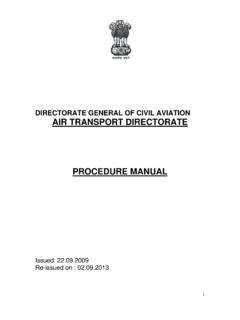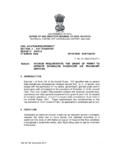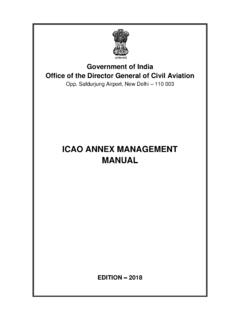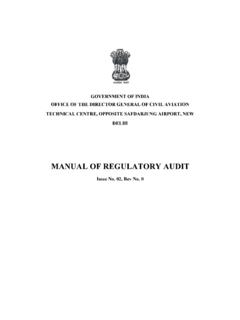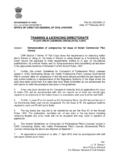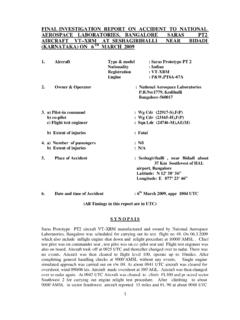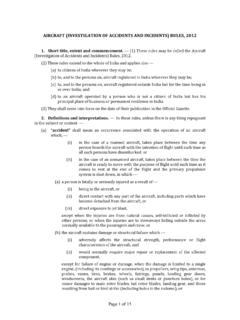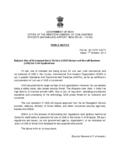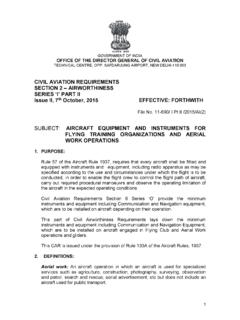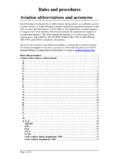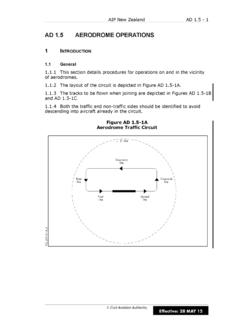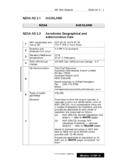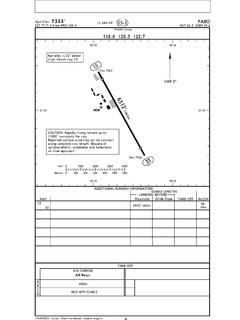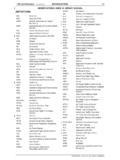Transcription of AERODROME ADVISORY CIRCULAR
1 GOVERNMENT OF INDIA CIVIL AVIATION DEPARTMENT OFFICE OF DIRECTOR GENERAL OF CIVIL AVIATION AD AC NO. 03 of 2017 12th July 2017 AERODROME ADVISORY CIRCULAR SUBJECT: MANPOWER REQUIREMENTS FOR AERODROME RESCUE AND FIRE FIGHTING OPERATION 1. Introduction The effectiveness of any fire fighting system depends on quality of equipment and competency & adequacy of manpower deployed for the purpose. Para of CAR Section 4, Series B, Part-I specifies the requirements for ARFF equipment and para recommends the AERODROME operators to carry out task resource analysis for determining the minimum number of fire fighting personnel required for their AERODROME .
2 This CIRCULAR is issued for the purpose of providing guidance to the AERODROME operators regarding methodology to be adopted for carrying out the task resource analysis for ascertaining the minimum manpower requirements for AERODROME rescue and fire fighting. It is important to note that this CIRCULAR on its own does not change, create, amend or permit deviations from regulatory requirements, nor does it establish minimum standards. The minimum requirements should be established including minimum number of RFFS vehicles and equipment required for the delivery of the extinguishing agents at the required discharge rate for the specified ICAO RFFS category of the airport.
3 It is also to be documented in AERODROME manual. In case, it is required for the RFFS to attend structural incidents and road traffic accidents in addition to aircraft incidents/accidents, additional resources should be allocated for the same and robust procedures shall be established by AERODROME operator so that it does not have any impact on the response time as per the declared fire category of the AERODROME . Note: ICAO Doc 9137-AN/898 Airport Services Manual Part 1 Rescue and Fire Fighting may be referred in this regard for detail guidance.
4 2. General Information. Human Factors The Task Resource Analysis (TRA) should observe human factor principles to obtain optimum response by all existing agencies participating in emergency operations. The principles should include the effects of human performance for example workload, capabilities, functions, decision aids, environmental constraints, team versus individual performance and training effectiveness. The examples given are illustrative and not exhaustive. (a) A Task and Resource Analysis consists of the following:- (i).
5 A scenario for analysis. (ii). Identification of the tasks that need to be carried out for that scenario. (iii). A time line, identifying when individual tasks are to be carried out. (iv). The number of persons required to carry out individual tasks (due account should be taken of fatigue, health and safety issues etc.). (v). All the tasks identified within the scenario. Every airport is unique in that the location, environment, runway and taxiway configuration, aircraft movements, airport infrastructure and boundary etc.
6 May present specific additional risk, hence it is imperative to consider these factors in Task and Resource Analysis. This process should be undertaken for a number of different scenarios. It may be useful to run the process as a table top exercise, involving a number of disciplines. (b) The following elements should be taken into the consideration for The scenarios and analysis should take into consideration of following elements including: (i). Aircraft types using the AERODROME ; (ii). The RFFS vehicle(s) and (iii). The use of self-contained breathing apparatus (SCBA); (iv).
7 Hand lines; (v). Ladders; and (vi). Other rescue and fire-fighting equipment provided at the AERODROME associated with aircraft RFFS operations. (c) Identify the types of aircraft commonly in use at the airport as the type of aircraft and its configuration has a direct bearing on the resources required in meeting Phase 1 below, it may be necessary to group the aircraft types in relation to common aircraft configurations for ease of analysis or identify precise aircraft type that may have a unique configuration. Example: (i) Long wide-bodied aircraft with multiple passenger decks and multiple aisles.
8 Airbus A380, Boeing 747, etc. (ii) Long narrow-bodied aircraft with single aisle, high passenger density. Airbus A 320,Boeing 737,etc. (iii) Short narrow-bodied aircraft with single aisle, high passenger density. ATR (d) The minimum requirements should be established including minimum number of RFFS vehicles and equipment required for the delivery of the extinguishing agents at the required discharge rate for the specified ICAO RFFS category of the AERODROME . (ref. CAR Section 4, Series B, Part-I, Table 9-2 and ). (e) One of the most important elements of a TRA is to identify and assess the impact of any critical tasks or pinch points identified by the analysis.
9 The nature of the analysis will differ depending on whether it is an assessment of the existing RFFS deployment at the AERODROME or planning for future requirements. (f) The assessment should examine the workload and identify the effectiveness of the staffing level. Where shortfall(s) or pinch point(s) are found the analysis should identify the additional staffing or equipment required to address them. (g) The following items will assist in determining the basic contents of an analysis: (i) Description of AERODROME (s) including the number of runways.
10 (ii) Promulgated RFFS Categories (Aeronautical Information Publication). (iii) Response Time Criteria (Area, times and number of Fire Stations). (iv) Current and future types of aircraft movements. (v) Operational Hours. (vi) Current RFFS Structure and Establishment. (vii) Current Level of operational crews. (viii) Level of Supervision for each operational crew. (ix) RFFS Qualifications/Competence (Training Programme and Facilities). (x) Extraneous Duties (To include Domestic and First Aid Response). (xi) Communications and RFFS Alerting system including Extraneous Duties.
